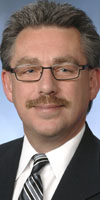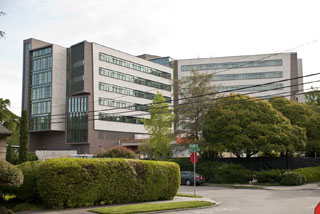|
Subscribe / Renew |
|
|
Contact Us |
|
| ► Subscribe to our Free Weekly Newsletter | |
| home | Welcome, sign in or click here to subscribe. | login |
Architecture & Engineering
| |
 |
July 26, 2012
When hospitals expand, traffic concerns follow
Transpo Group

Gahnberg
|
My wife, Linda, and I sat in the lobby at the University of Washington Medical Center on the evening of March 7, waiting for a room to become available so she could be prepped for her heart transplant.
We had been in and out of the hospital for three months while waiting for a transplant. Since her heart issues began last fall, I had imagined that when the call for her transplant came, the process would go very fast, like having a baby. The amount of time we would spend waiting in lobbies for a bed never crossed my mind.
While we waited, I could not help but reflect upon many of the public meetings I had sat in during the master planning process for health care projects, listening to stories of parents with sick children who had care delayed or were given a bed in a hallway because of the critical bed shortage the hospital faced. Nevertheless their testimonies and the ultimate “need” for expansion were questioned.
My wife and I had also experienced the bed shortage in our own trip to the UWMC emergency room. Instead of being transferred to a bed in the cardiac care unit, we were required to stay in the ER for over 18 hours waiting for a bed upstairs. During all of our time at UWMC, it was clear that the space constraints were a constant dilemma.
Need for balance
Seattle is home to some of the finest medical institutions in the country. However, many are located in what are increasingly challenging urban environments. When hospitals must expand, these environments present transportation and access concerns for not only vehicles, but also pedestrians and cyclists.
The ability of health care facilities to continue to provide world-class care requires balancing the needs of the institution with those of the surrounding neighborhood, and relying on innovative technology and creative transportation approaches to provide a solution. In constrained environments, solutions are often balanced compromises between equally important interests.
Sophisticated traffic system
UWMC is situated on a small site near the Burke Gilman Trail and across the street from Husky Stadium and the future Sound Transit station. There is little land available for expansion, yet there is a chronic shortage of available beds, leading to the need for additional floors.
Successful expansion required extending the tower over Columbia Road, a primary campus circulation route that serves cars, buses and shuttles, and provides access to hospital loading docks. The required vertical support columns would narrow Columbia Road to a single lane.
Maintaining safe passage for all modes of travel was critical to campus operations, and critical to saving lives at UWMC. Safely accommodating all of these modes provided a unique design challenge.
An innovative application of “intelligent transportation system” technology to the service and loading area allows trucks and service vehicles to safely maneuver without conflicting with roadway traffic.
To the typical driver or cyclist going by, the system appears to be a simple signal. However, the system’s backbone is a sophisticated control system utilizing video-detection technology and multiple programs that change depending on the type of detection the signal receives from cars, bikes, pedestrians and trucks.
The end result safely manages conflicting traffic in the confined space. This elegantly simple solution was just one critical piece in allowing the hospital to expand its life-saving services.
A multimodal plan
Seattle Children’s Hospital presented a different set of challenges. The northeast Seattle hospital has seen its surrounding neighborhood grow dramatically since the hospital was built in 1953, and the community has become increasingly sensitive to the traffic the hospital creates.
Nevertheless, critical bed shortages required that the hospital plan for growth. A 20-year major institution master plan was prepared allowing for an increase in beds from 254 to 500-600, plus other support space.
As part of this planning process, Seattle Children’s developed a multimodal transportation plan that included strategies to further reduce trips from single-occupant vehicles and help the hospital best integrate into the neighborhood. Enhancing bicycle and pedestrian accessibility and improving access to the Burke Gilman Trail were central to supporting an aggressive transportation-management plan.
Overall, Seattle Children’s contributed $4 million to improving multimodal transportation in northeast Seattle, of which approximately $2 million was budgeted for pedestrian and bicycle improvements alone.
This plan evolved into the Seattle Children’s Livable Streets initiative, which engages citizens and the surrounding Laurelhurst neighborhood in identifying potential improvement projects. This process has resulted in northeast Seattle’s first greenway, implementation of new communication technology that provides useful driver information, and transportation improvements that enhance travel for cars, pedestrians, bicycles and emergency vehicles.
“By leveraging the hyperlocal knowledge of our neighbors, our transportation plan has found a sweet spot between access, safety and livability,” said Paulo Nunes-Ueno, director of transportation and sustainability at Seattle Children’s.
“The collaborative process used to develop the plan helped us integrate innovative solutions such as greenways and smart signal technology to improve the connections that were most valued by our neighbors.”
A new signal at Sand Point Way Northeast and 40th Avenue Northeast not only improves traffic flow, access and safety, it also provides an inviting front door to the new lower campus.
The new signal integrates with the overall campus design and adjacent bicycle boulevard, and is a key component linking people and bicycles to the Burke Gilman Trail. The design minimizes pedestrian crossing distance and improves crossing safety on Sand Point Way.
Looking ahead
UWMC and Seattle Children’s are tremendous assets to the region and the patients they serve, including my wife, Linda.
To continue as regional health care leaders they must grow to meet increased demand. Achieving that growth requires an engaged balance between the needs of the institution and the evolving needs of communities.
Creative multimodal planning, strategic application of emerging technologies, and early engagement with the community all provide new avenues for enabling growth and ensuring that many patients to come can experience the same happy ending as my family.
Kurt Gahnberg is a principal at Transpo Group and has over 30 years of transportation planning consulting experience.
Other Stories:
- Lean design is different for every health care project
- Simulations playing wider role in nursing education
- Former TV studio remodeled into dialysis clinic
- Silverdale hospital sets ambitious budget for new wing
- Virtual tools put Everett tower on the fast track
- Clinic designs evolving to meet growing list of needs
- Hospital’s mechanical design process a complex dance
- Tight UW site left nowhere to go but up
- Builder’s challenge: Keep UW hospital running smoothly



